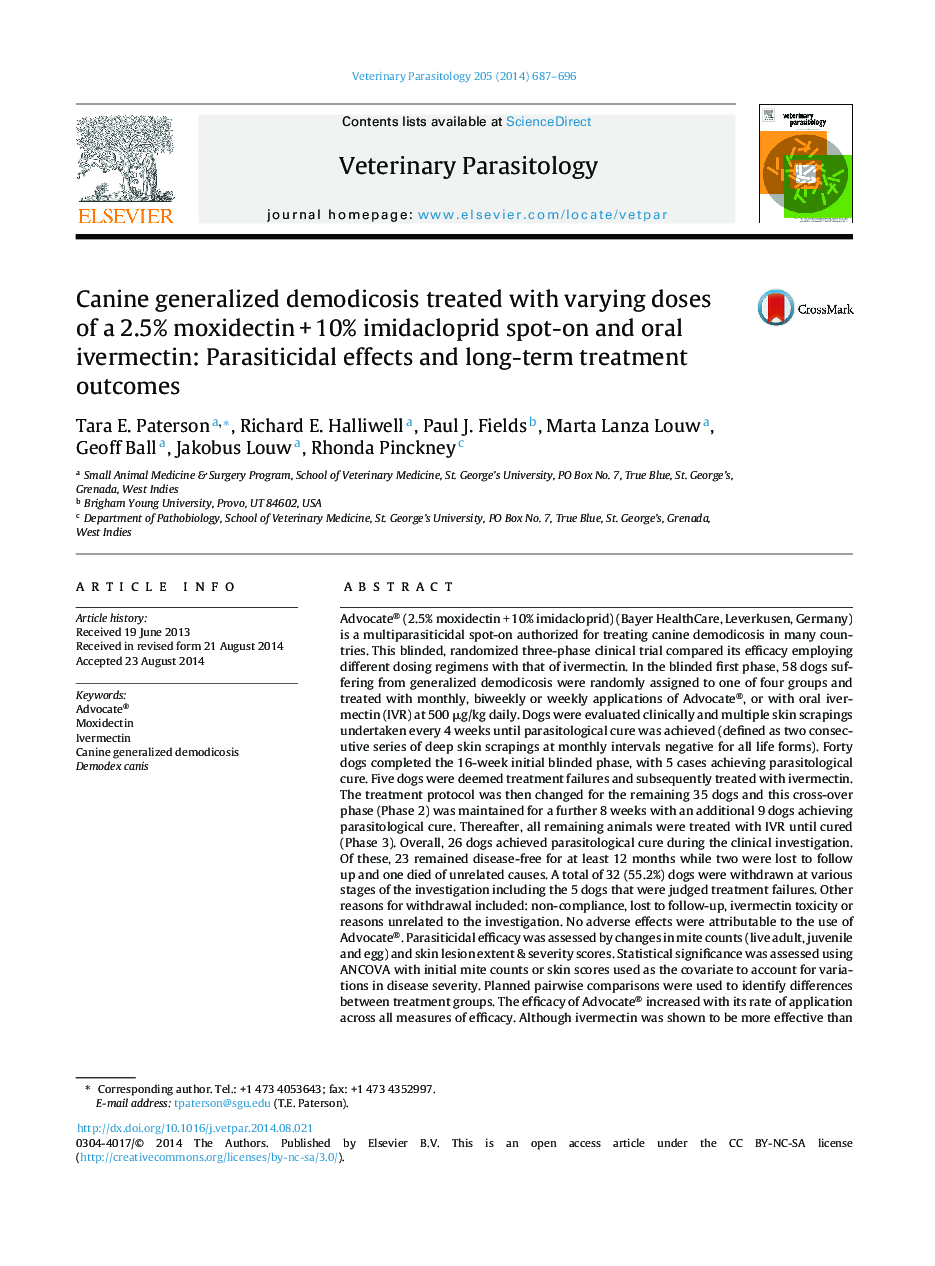| کد مقاله | کد نشریه | سال انتشار | مقاله انگلیسی | نسخه تمام متن |
|---|---|---|---|---|
| 5803102 | 1555680 | 2014 | 10 صفحه PDF | دانلود رایگان |

- Weekly application of Advocate® is an effective treatment for severe CGD.
- No adverse effects resulted from weekly application of Advocate®.
- Time to parasitological cure increases proportionally to the initial mite burden.
- Several dogs developed ivermectin toxicity during the clinical trial.
- All dogs achieving parasitological cure remained in remission for one year.
- The efficacy of Advocate ® increases with frequency of application.
Advocate® (2.5% moxidectin + 10% imidacloprid) (Bayer HealthCare, Leverkusen, Germany) is a multiparasiticidal spot-on authorized for treating canine demodicosis in many countries. This blinded, randomized three-phase clinical trial compared its efficacy employing different dosing regimens with that of ivermectin. In the blinded first phase, 58 dogs suffering from generalized demodicosis were randomly assigned to one of four groups and treated with monthly, biweekly or weekly applications of Advocate®, or with oral ivermectin (IVR) at 500 μg/kg daily. Dogs were evaluated clinically and multiple skin scrapings undertaken every 4 weeks until parasitological cure was achieved (defined as two consecutive series of deep skin scrapings at monthly intervals negative for all life forms). Forty dogs completed the 16-week initial blinded phase, with 5 cases achieving parasitological cure. Five dogs were deemed treatment failures and subsequently treated with ivermectin. The treatment protocol was then changed for the remaining 35 dogs and this cross-over phase (Phase 2) was maintained for a further 8 weeks with an additional 9 dogs achieving parasitological cure. Thereafter, all remaining animals were treated with IVR until cured (Phase 3). Overall, 26 dogs achieved parasitological cure during the clinical investigation. Of these, 23 remained disease-free for at least 12 months while two were lost to follow up and one died of unrelated causes. A total of 32 (55.2%) dogs were withdrawn at various stages of the investigation including the 5 dogs that were judged treatment failures. Other reasons for withdrawal included: non-compliance, lost to follow-up, ivermectin toxicity or reasons unrelated to the investigation. No adverse effects were attributable to the use of Advocate®. Parasiticidal efficacy was assessed by changes in mite counts (live adult, juvenile and egg) and skin lesion extent & severity scores. Statistical significance was assessed using ANCOVA with initial mite counts or skin scores used as the covariate to account for variations in disease severity. Planned pairwise comparisons were used to identify differences between treatment groups. The efficacy of Advocate® increased with its rate of application across all measures of efficacy. Although ivermectin was shown to be more effective than Advocate® applied once weekly, both treatment protocols produced clinically satisfactory results. It was concluded that weekly application of Advocate® can be recommended as effective for the treatment of canine generalized demodicosis without the potential for toxicity associated with ivermectin.
Journal: Veterinary Parasitology - Volume 205, Issues 3â4, 15 October 2014, Pages 687-696